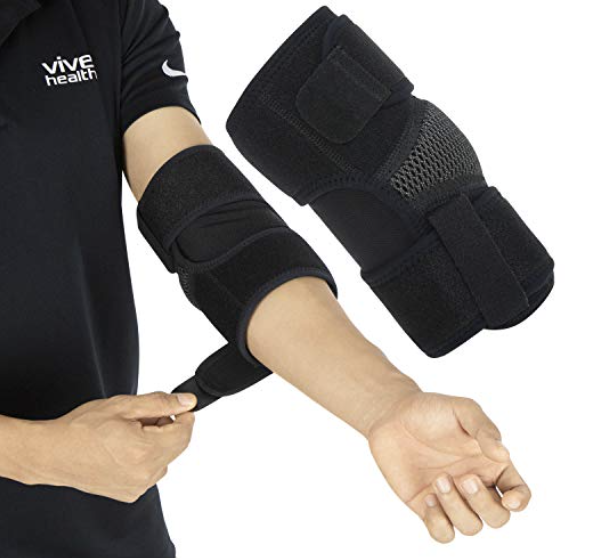Tennis Elbow Brace
What is Tennis Elbow?
Tennis elbow, also known as lateral epicondylitis, is an injury to the muscles of the elbow and forearm. It is caused by repetitive actions that involve the arm being moved back and forth or twisted. This action, typically from activities like playing tennis, can result in micro-tears in the muscles of the elbow and forearm, which leads to pain and inflammation. The best tennis elbow brace can provide support which helps to reduce the inflammation and pain.
The best tennis elbow braces are made from either neoprene or woven material, such as jersey or spandex. It applies compression over the affected area to provide stability and reduce strain on the muscles and ligaments. By immobilizing the elbow and forearm in a secure way, the best tennis elbow brace can help alleviate pain and inflammation while allowing the athlete to return to their regular activities more quickly.
The Causes of Tennis Elbow
Tennis elbow is a painful condition of the elbow caused by overuse. Repetitively using the same set of arm and hand muscles can lead to inflammation and soreness at the lateral epicondyle. People who play racquet sports, such as tennis or badminton, are at an increased risk of developing tennis elbow due to the powerful movements required for these activities. However, many other activities can lead to this condition, such as carpentry, plumbing, welding, painting and grooming.
The best brace for tennis elbow is designed to alleviate pressure on the affected area to reduce pain. This is achieved through compression on the tendon attachment and tendonitis area. The brace should be comfortable enough to be worn for long periods of time, and should have an adjustable strap that allows for a custom fit. It is important to seek out appropriate guidance when selecting a brace, as other braces may not provide the needed level of support.
Common Causes of Tennis Elbow:
- Overuse of the same set of arm and hand muscles
- Repetitive movements during activities such as tennis, badminton, carpentry, plumbing, welding, painting and grooming
- Poor technique or form when playing racquet sports or engaging in other activities
Symptoms of Tennis Elbow
Patients with tennis elbow usually suffer from localized discomfort that extends from the outside of the elbow joint to the forearm and wrist. This pain is typically aggravated by wrist and forearm movements such as gripping. Patients may also experience weakness in the wrist and forearm when performing these activities. A common symptom is feeling a snapping sensation in the elbow joint when performing certain movements. In some cases, swelling and tenderness may be present around the elbow. Wearing an elbow brace for tennis elbow can help reduce some of these symptoms.
In worst cases, the pain from tennis elbow can be so severe that it disrupts activities of daily living. It is important to speak to a doctor and discuss treatment options if the pain persists for more than a few days. Regardless of the severity, elbow braces for tennis elbow can often provide relief. These braces are designed to provide support and stability to the affected area, while also allowing the muscles to heal and strengthen.
Diagnosis of Tennis Elbow
A doctor can diagnose tennis elbow through a physical examination and medical history. A doctor may test range of motion and muscle strength in the elbow joint. Common signs that might be present are tenderness in the elbow and pain when touching the elbow or holding any kind of weight. A doctor may also ask questions related to any recent injuries or activities that have been involved with the elbow.
To confirm a diagnosis of tennis elbow, the doctor may use imaging scans such as an X-ray or MRI scan. These scans can help to show any problems, such as bone fragments or inflamed tendons that might be causing the pain. Once tennis elbow has been confirmed, the doctor may recommend treatments such as rest, medications, stretching and exercise, or a Tennis Elbow Brace. Wearing a brace can provide extra support to the elbow joint to reduce pain and inflammation, so it is important to choose a brace that fits correctly and to follow the instructions on how to wear it correctly.
Treatment Options for Tennis Elbow
The primary treatments for tennis elbow include rest, activity modification, anti-inflammatory medications and physical therapy. Non-surgical treatment for tennis elbow is effective for most people, as it helps reduce pain and inflammation while protecting the ligament against further damage. An athlete should avoid activities that may aggravate the elbow until the pain and inflammation resolves. These may include activities such as racquet sports, but any activity that involves gripping and repetitive twisting motions should be limited.
In addition to rest and activity modification, non-steroidal anti-inflammatory medications (NSAIDs) are commonly prescribed for pain and inflammation. This can help reduce irritation of the tendon and improve healing. Several different methods of physical therapy have been advocated to help manage tennis elbow, including stretching, strengthening, and other rehabilitative exercises. In some cases, a splint may be applied to reduce tendon irritation and improve healing. In more severe cases, a corticosteroid injection may be considered to reduce inflammation and facilitate healing.
Tennis Elbow Brace Frequently Asked Questions
What is Tennis Elbow?
Tennis Elbow, also known as Lateral Epicondylitis, is a condition that is caused by overuse of the muscles and tendons of the forearm. It is typically caused by repetitive motions of the arm and elbow, such as those involved in the game of tennis, and can be incredibly painful.
What are the Causes of Tennis Elbow?
Repetitive motions of the arm and elbow can cause the tendons of the elbow to become strained and irritated. This can be due to a number of activities, such as sports like tennis, golf, or other activities involving repetitive motions.
What are the Symptoms of Tennis Elbow?
The most common symptom of tennis elbow is pain or tenderness in the outside of the elbow. Other symptoms include aching or burning sensation around the outside of the elbow, pain with gripping or gripping objects, or weakened grip strength.
How is Tennis Elbow Diagnosed?
A diagnosis of tennis elbow is typically made based on a physical examination combined with the patient’s account of their symptoms and medical history. Imaging tests such as X-rays or MRI scans may be ordered to help rule out other conditions.
What are the Treatment Options for Tennis Elbow?
Treatment for tennis elbow typically begins with rest, ice, and over-the-counter medications to help reduce pain and inflammation. Physical therapy, corticosteroid injections, and other treatments may also be recommended depending on the severity of the condition. In some cases, surgery may be necessary to repair the damaged tendons.
- How To Choose The Best Lap Desk For Laptop And Writing - 15 October 2023
- How To Choose The Best Projection Screen With Foldable Stands - 14 October 2023
- How To Choose The Best Antifungal Pill For Dogs - 13 October 2023

